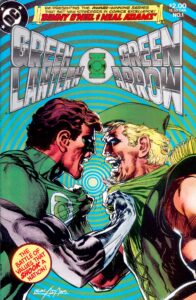Neal Adams, 1941-2022
by Tony Keen 03-May-22
We sadly note the passing of Neal Adams.
 It is our sad task to note the passing on 28 April of comics artist and writer Neal Adams at the age of eighty. Adams began his comics career in 1964 at the Newspaper Enterprise Association, where he drew the strip Ben Casey, based on a then-popular tv medical drama. But it is his work in the late 1960s and early 1970s for which he will be most remembered. Here are some selected highlights.
It is our sad task to note the passing on 28 April of comics artist and writer Neal Adams at the age of eighty. Adams began his comics career in 1964 at the Newspaper Enterprise Association, where he drew the strip Ben Casey, based on a then-popular tv medical drama. But it is his work in the late 1960s and early 1970s for which he will be most remembered. Here are some selected highlights.
For DC, he drew Deadman between 1967 and 1969, with Arnold Drake doing the scripts until Adams took over writing himself for the last six months. From 1968 onwards he illustrated several Batman stories, many with writer Dennis O’Neil; O’Neil and Adams took Batman away from the campy hero he had been in much of the 1940s and 1960s, and in the tv show, and back to the brooding crimefighter of the 1940s, and he’s been that way ever since. Most spectacularly, in 1970 O’Neil and Adams revamped Green Lantern, teaming him with Green Arrow, and introducing contemporary social issues in a way that simply hadn’t been done before at DC, and not much at Marvel.
Over at Marvel, Adams had two memorable collaborations with Roy Thomas. On X-Men, they managed to stave off cancellation for about ten months with a series of first class stories in 1969 and 1970, whilst Adams also illustrated (most of) ‘The Kree-Skrull War’ for Avengers in 1971-1972, which has rarely, if ever, been bettered in terms of Avengers cosmic efforts.
Adams introduced a realism into superhero art—he famously once said to O’Neil that ‘if super-heroes existed, they’d have to look the way I draw them’—that contrasted with the dynamism of Jack Kirby’s Marvel work. Adams was, of course, influenced by Kirby, but more by the Kirby of the 1940s and 1950s than the Kirby of the Fantastic Four and Thor. And there are other influences, most notably Alex Toth. To all of this is added a sense of movement and composition that is almost cinematic at times. Adams forms the missing link between Kirby and people like John Byrne and George Pérez.
Much of Adams’ later work is not particularly worth seeking out; Ms. Mystic is historically important in the emergence of creator-owned independent comics in the 1980s, but it’s not actually very good. But Adams was also an important political force within comics. He was one of the first artists to freely work for both Marvel and DC, when that really wasn’t done, and his campaigning led to the return of some of Jack Kirby’s artwork to Kirby by Marvel, and to DC giving credit and some money to Jerry Siegel and Joe Schuster for Superman.
And for that work from 1967 to 1974, Adams was one of the greats of the industry.
Tags: Neal Adams